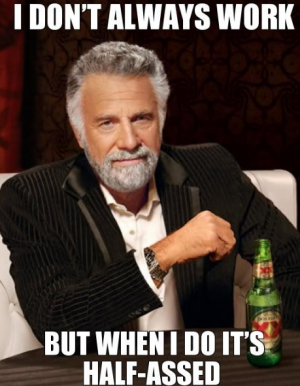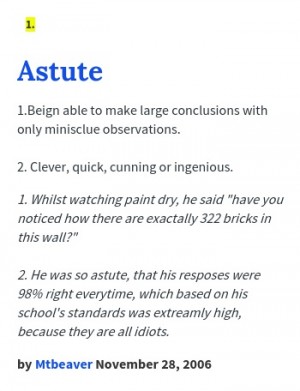 I mean this article to be the first installment in a series.
I mean this article to be the first installment in a series.
The underlying principle is the Anna Karenina principle
The Anna Karenina principle
The Anna Karenina principle is: good systems must meet simultaneously a number of requirements. All good systems are alike, bad systems are bad in their own way
Tolstoy said: Happy families are all alike; every unhappy family is unhappy in its own way
Aristotle said: success/failure: …it is possible to fail in many ways (for evil belongs to the class of the unlimited, as the Pythagoreans conjectured, and good to that of the limited), while to succeed is possible only in one way (for which reason also one is easy and the other difficult — to miss the mark easy, to hit it difficult); for these reasons also, then, excess and defect are characteristic of vice, and the mean of virtue;
good/bad: …For men are good in but one way, but bad in many.
But under the Anna Karenina principle there is an even deeper layer, the cause of the principle, and that is what we are interested in here.
The roots… Because unless you are dealing with the roots, you are still playing with yourself, kidding yourself, pinning cherries on the apple tree hoping it will make it a cherry tree.
So, the underlying principle is this:
How you do anything is how you do everything. 1
It’s been the most useful “coaching” I have ever received.
But it is becoming not useful when I am giving it to you. Why?
Because you can’t see the how… because it is not on the surface, and because you only see with your eyes.
We could say that the number one predictor of success in life is awareness… but not surface awareness… that is highly overrated. Deep awareness. The awareness of the how…
So what is this how? It can be called an attitude. Attitude is your relationship to something.
What you say about it
What you feel about it
What you want from it
What you are willing to give it
The Hungarian word for it is “how you stand in relationship to it”
One of my students, in answer to the questions in the 67 steps, (Step 13) wrote:
1. I have been vacation minded for most of my working life. I’ve spent 98% of my working life doing accounting work for small and large businesses, full time and part time. At all these jobs, the time away from work is what I look forward to.
The other 2% of my work life was spent working with animals. During those time I wasn’t thinking about my time off from work.
2. When I wake up, I most certainly do NOT feel like tap dancing to work. Again, in the 98% of my work life I feel like I”m wearing concrete shoes when I wake up. The 2% is when I feel like tap dancing to work.
My answer:
OK, this is the first time I feel you are in this program.
I am going to write an article about this, because I don’t think you are the only person who cannot see…
But the gist of it is this: when you are vacation minded, you are, in essence, in a mindset of “something is better than this, somewhere is better than here”.
That is the how… in the how you do anything is how you do everything.
If you look, it is even in your vacation time. You cannot give yourself fully to something, if you withhold yourself somewhere else.
So you’ll notice it in sex, in being with your daughter, even in eating, or talking to me.
You are never giving yourself fully
.
Unless you are astute you won’t see what is the “how” in anything, unless I point it out
Astute is the ability to identify, with precision and accuracy, what is really going on. What you are really looking at. The distinction, not the surface.
The error always comes from not seeing distinction. Seeing the example, not the distinction.
 Wanting to be on vacation instead of work, is just an example that fits a distinction.
Wanting to be on vacation instead of work, is just an example that fits a distinction.
Wanting to be thin instead of chubby… is another example that fits the same distinction.
Wanting someone to be nice to you instead of somebody else… is yet another example that fits the same distinction.
I could give you thousands of examples, because once you “get” the distinction, you can see it everywhere, in everything. But a thousand examples won’t give you the distinction… unless you are astute enough to get it.
Astuteness is an intangible capacity… encoded in a gene, either expressed or unexpressed. If you have the standard 5-7 active (expressed) capacities only, you can be sure you don’t have “astute” active… None of my students have it fully activated, but one of them has it halfway open, since yesterday.
Should I give up teaching through distinctions because you are not astute? Good question. Maybe I should, but then again, why teach surface that doesn’t teach anything?
In the 67 step coaching I attempt to bring students’ attention to the distinction. I prohibit them from participating with “garden-variety” 67-step participants, because those people don’t know anything about distinctions. Tai Lopez is astute, but he doesn’t know distinctions either, he doesn’t know that he teaches through distinctions. Weird, eh?
Reminder: the distinction we are looking at is “something is better than this, someplace is better than here”
The “attitude” of it is never it.
Let me say it differently: the tendency to never say “this is it”.
Instead you say: “this isn’t it.”
Now, why would you say that? After all, is there an “it” really?
You say it because you get some sneaky “payoff” from saying it.
You never have to put out, you never have to commit, you never have to be on the hook for anything.
Instead you hold yourself back, instead you are in waiting mode, hoping mode, where one day some day it will be it.
But… it never will be. Because even if the “it” comes, even if your ship comes in, your attitude will remain “this isn’t it” and your mood will remain “something is better than this”.
If we wanted to create an illustration for this attitude
If we wanted to create an illustration for this attitude, we would ask the person to be leaving what they are relating to.
One step out the door…
Recognize it? More familiar? See it on others?
Now, go and start detecting it on yourself.
The attitude is not fixable… Nothing wrong with it, it is just a possible way to be… one possible way to be joyless, and unhappy. And powerless. And miserable. And withholding yourself.
When someone’s attitude is: “This is it!” We are looking at the ONLY WAY to be effective, happy, and close.
If we wanted to create an illustration for this attitude
When you want to illustrate this attitude, “this is it”, you see someone fully there, fully connected, fully invested.
Oh, it’s scary? Hell yeah. Who ever said that life was going to be easy.
You see, until your attitude to life and everything in it is “this is it” you haven’t started to live yet.
And most likely you’ll die, without ever having lived.
I am sorry, dear, but you need to get wet.
The work of transformation is not about making life less risky. The work of transformation is to take the risk that life is… and say: this is it.
Not reluctantly, not timidly, not dutifully, not because I asked you to, but because until you do, you have no power in anything you do.
Half-assed is another expression that may communicate this attitude.
- I learned this from T. Harv Eker. One of his famous sayings was that he could tell your financial future in a few seconds talking to you.
The conversation didn’t have to be about anything important, relevant topic… He was using this principle to “diagnose” your life. Because he wasn’t just teaching this principle, he lived it. He had it as a distinction… How you approached him, how you asked for what you asked for, revealed to him how you live your life. All of it.




